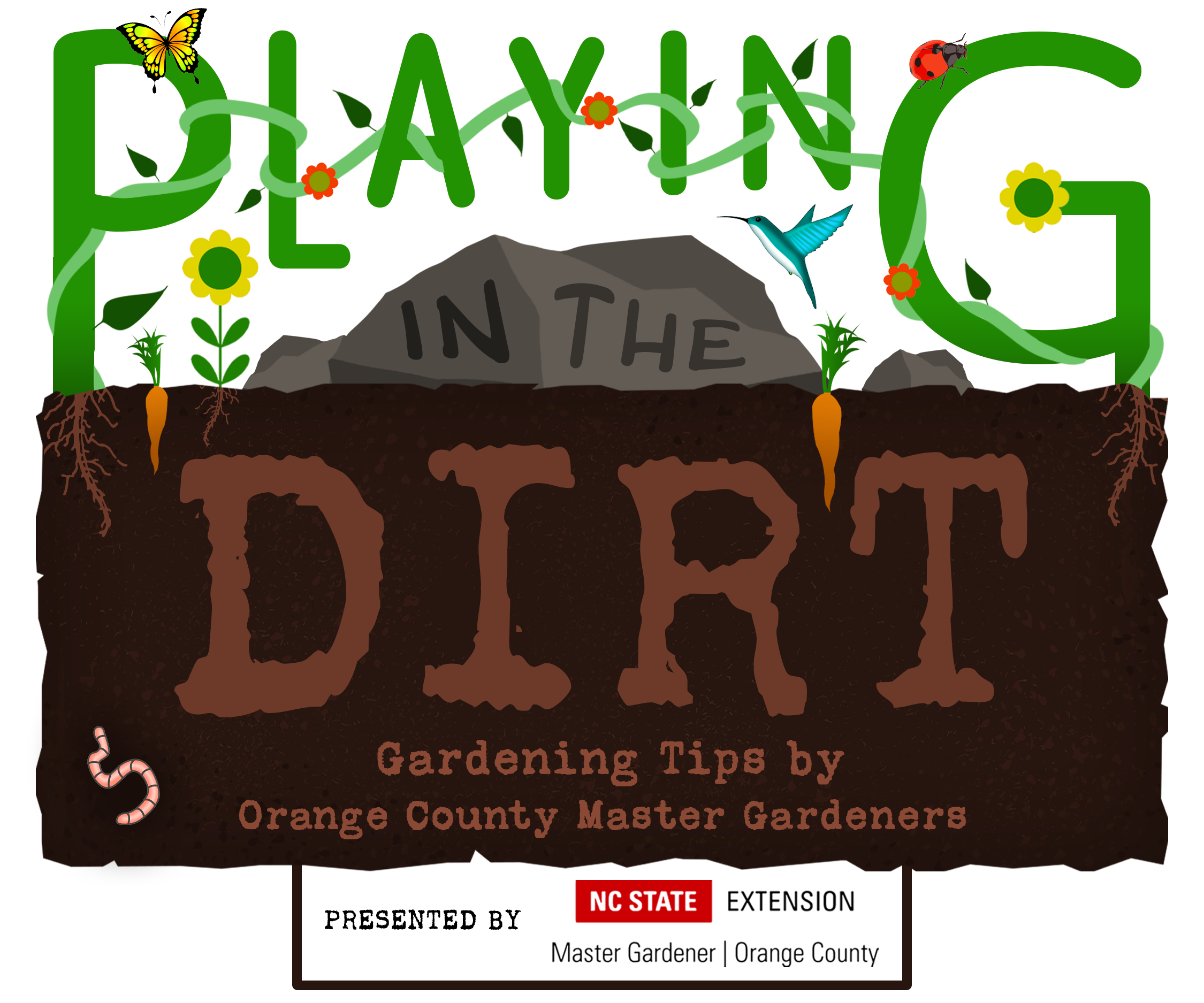
97.9 The Hill and Chapelboro.com have partnered with NC State Extension Master Gardener℠ volunteers of Orange County for “Playing in the Dirt,” a monthly column providing information and inspiration to gardeners of all skill levels! Check back on Chapelboro each month for a new subject – from our gardens to yours!
By Lynn Calder, Orange County Master Gardener℠ volunteer
October was busy for Master Gardener volunteers in Orange County! Thanks to many of you, PlantFest was a huge success! We appreciate everyone who ventured out in the cool, rainy weather and purchased plants to help fund our educational pursuits, visited our booths inside to learn more about gardening and brought children to participate in all our kids’ activities.
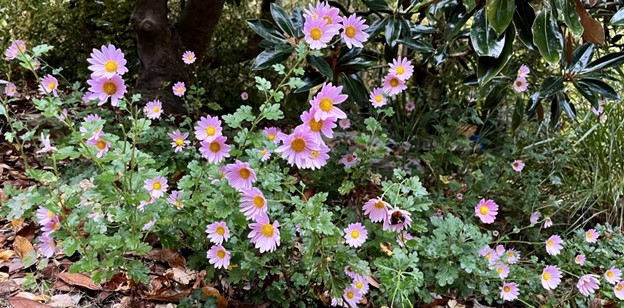
Hardy chrysanthemums (Rubellum Group) are a colorful sign of fall and feed pollinators. (Photo by Lynn Calder.)
Now, back to tending our gardens! Even late fall is a great time to garden — perfect for planting certain varieties of trees, shrubs, perennials, bulbs and seeds, preparing cool season lawns for winter and performing routine garden care.
Here are some tips for tasks to undertake in your gardens over the next month. Special thanks to Leigh Simpson for providing much of this information which can be found in more detail in The Orange Gardener. Monthly gardening Tips & Tasks are published in The Orange Gardener categorized by tabs for plants you might enjoy adding to your yard and tips/tasks for lawn, ornamental plantings, edible gardens and wildlife. You can also download this handy monthly chart.
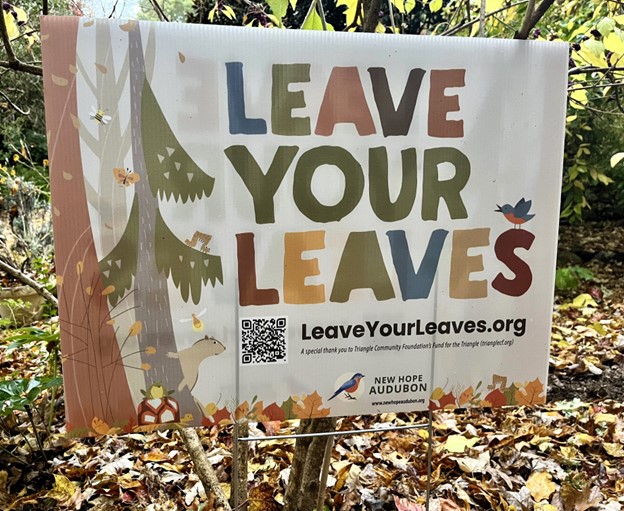
New Hope Audubon advice and free sign. (Photo by Lynn Calder.)
Leave the Leaves
Good news! It’s far better for most of your landscape and the wildlife that depends on it to leave leaves on the ground rather than remove them. You do want to remove dead vegetable plants, spent flowers, moldy perennial stems and any infected or infested plants because they can harbor diseases or harmful insects, but think twice before a complete garden clean-up. Flower heads on dormant plants provide food for birds and insects during the winter and leaf litter provides a home for insects that are food sources for birds and other wildlife. The leaves also provide a layer of mulch to protect plant roots and enrich the soil as they decompose.
When you do need to remove leaves, such as from turf areas to avoid suffocating cool season lawns, consider saving them in a mulch or compost pile. They will break down quicker if you shred them with a mower and collect them in a bag attachment
Cover Bare Soil
Cover any bare soil over the winter to prevent erosion and pesky weed growth and provide beneficial nutrition. Organic mulch (such as the leaves you may have raked or shredded) will decompose to help the soil. A cover crop like crimson clover, a legume, grown over the winter and turned under in spring will add nitrogen. Legume seeds should be planted and established before frost if possible; if seeds are planted late, be sure to cover with a shallow layer of soil rather than spreading on top of the soil (check the package instructions).
Plant, Divide and Transplant
Fall is a good time for planting! Our soil usually stays warm enough for root growth all winter giving roots time to repair and grow before the stress of summer heat. See detailed instructions for preparing the soil and installing plants in The Orange Gardener, including special advice for planting trees.
Most species can be planted or transplanted now, including spring and summer-blooming perennials. The soil is still warm enough to give roots a chance to settle in but try to plant at least six weeks before the ground freezes hard. It is best, however, to wait until spring for planting or dividing the following: tender and most fall-blooming perennials; warm-season grasses and hostas; and species that require a full growing season to develop a good root system (examples are butterfly bushes, tap-rooted plants like baptisias and hybrid purple coneflowers; and slow-growing, fleshy-rooted evergreens like magnolias and camellias).
Hardy annuals like pansies, violas and ornamental kale thrive in cooler temperatures and can be planted now to provide color throughout the fall and into winter. Any plants you have left sitting in nursery pots will overwinter much better in the ground than in the pots.

Garden pansies. (Photo by Hanna Zelenko, CC BY-SA 3.0.)
New plantings should be watered thoroughly after planting and until the ground freezes if the soil dries out.
To conserve moisture and suppress weeds, add about one inch of organic mulch (such as straw, leaves or wood chips) around new plantings, keeping the mulch away from plant crowns. Our falls are often dry and deeper mulch can inhibit rainwater from reaching plant roots. Wait until early winter after a hard freeze to mulch established plants. Because mulch traps heat, it can increase susceptibility to winter damage by preventing plants from becoming dormant.
Bulbs and Seeds
Now is the time to plant spring-flowering bulbs so they can develop a strong root system before spring growth. In our area, the best time for planting is mid-November to early December when night temperatures are consistently below 60 degrees. The larger and firmer the bulb you choose, the better. If you buy bulbs early when the selection is best, you can store them in a ventilated container (not a plastic bag) in a cool (50 to 65 degrees), dry place until planting. Our winters are generally cold enough that you don’t need to worry about buying precooled bulbs as long as you plant them by early December.
While most bulbs prefer full sun, you may have more location options than first come to mind. Overhead trees are often still bare when spring flowering bulbs emerge and bloom and some bulbs such as daffodils and crocuses tolerate partial shade. Bulbs need soil with good drainage and grow best if the pH is between 6 and 7.
Planting depth depends largely on the size of the bulb. For most, the general rule is to plant it at a depth 2 ½ to 3 times the length of the bulb. Set bulbs upright in the hole with the roots facing down and apply a balanced fertilizer when you plant them.
For more tips on gardening with bulbs, see Plant Bulbs in the Fall for Delightful Spring Flowers.
If you’d like to create a wildflower garden, fall (from October through December) is the best time in our area for sowing wildflower seeds. This allows the seeds to germinate and grow slowly over the winter months for flowering early in spring. The seeds should be planted according to seed package instructions, usually at a depth of 1/8 to 1/4 inch. The newly planted seeds will not need water; they will lie dormant over the winter until the soil becomes warm enough to encourage growth of the young plants. Grow Wildflowers! provides details about placement, planting, and maintaining a wildflower garden.
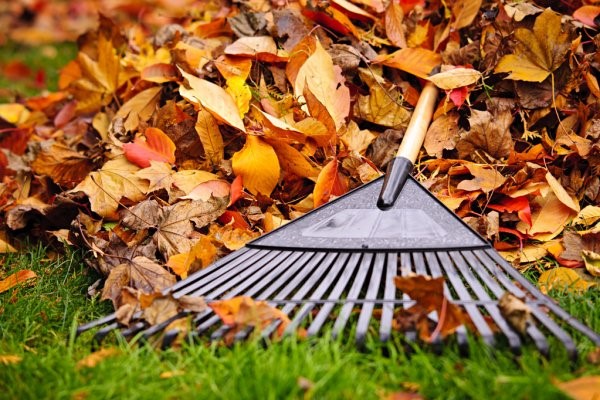
Heavy leaf layer can suffocate a cool-season lawn. (Photo from article by Debbie Dillion, Extension Agent, N.C. Cooperative Extension, Union County.)
Prepare Your Lawn for Winter
Cool-season lawns need some routine maintenance before winter, including removing leaves to keep grass from being smothered and mowing to a height of 3 to 3 ½ inches. Grass clippings may be left on the lawn to decompose and enrich the soil. If too plentiful, clippings may also be used as mulch or added to compost as long as they don’t contain herbicide. Water the lawn (if necessary) to ensure it receives about 1 inch of water weekly and is wet to a depth of 4 to 6 inches. November is a good month to apply fertilizer to cool-season lawns (one pound nitrogen per 1000 square feet).
Test your soil
Soil tests are free from April through November! Take advantage of the last month of free soil testing to check acidity and nutrient levels in your landscape’s soil. Soil test boxes are available at the N.C. Cooperative Extension office at 1020 US 70 West, Suite 130, Hillsborough, NC 27278 (across from the DMV driver’s license office). Learn all about soil and soil testing in It’s All About the Soil.
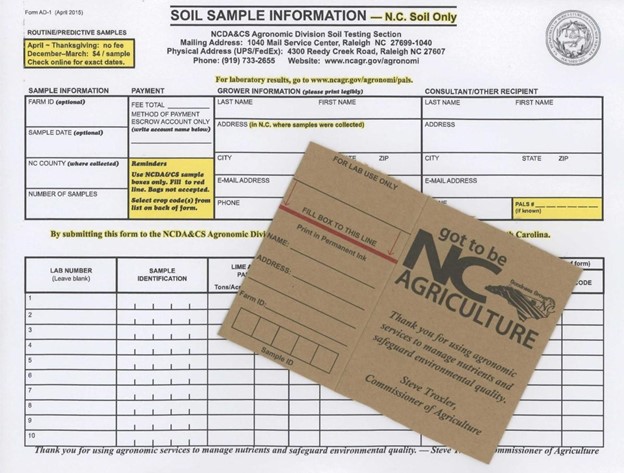
Pick up a Soil Testing Kit at the Orange County N.C. Cooperative Extension office!
Additional Resources:
- The Orange Gardener Tips & Tasks, NC State Extension Master Gardener℠ volunteers of Orange County
- Planting Trees and Shrubs Correctly, NC Cooperative Extension, Onslow County
- Recommended Fall-Planted, Spring Flowering Bulbs, NC Cooperative Extension, Chatham County
- Add Flowering Bulbs in Your Garden This Fall, NC Cooperative Extension, Forsyth County (four videos)
- TurfFiles, NC State Extension (extensive information about growing lawns in NC)
Check Us Out!
Join us for on November 18, 2023, 2-3:30 p.m. for our monthly Dig Deeper talk at the Orange County Library in Hillsborough. This month’s topic is Composting and Soil Prep. We’ll have free packets of seeds for you to plant! Please register on the library’s website. We will skip December and present talks again beginning in January 2024.
- Have a plant or garden question? Email the Orange County Master Gardener volunteers at ocmgardeners@gmail.com or phone 919-245-2061.
- Subscribe to The Garden Buzz, the Orange County Master Gardeners’ monthly newsletter, for gardening news and tips. And visit our website, The Orange Gardener, for helpful gardening information and tips.
- Follow us on Facebook! Our page is Orange County NC Extension Master Gardener Volunteer.
Chapelboro.com does not charge subscription fees, and you can directly support our efforts in local journalism here. Want more of what you see on Chapelboro? Let us bring free local news and community information to you by signing up for our biweekly newsletter.

